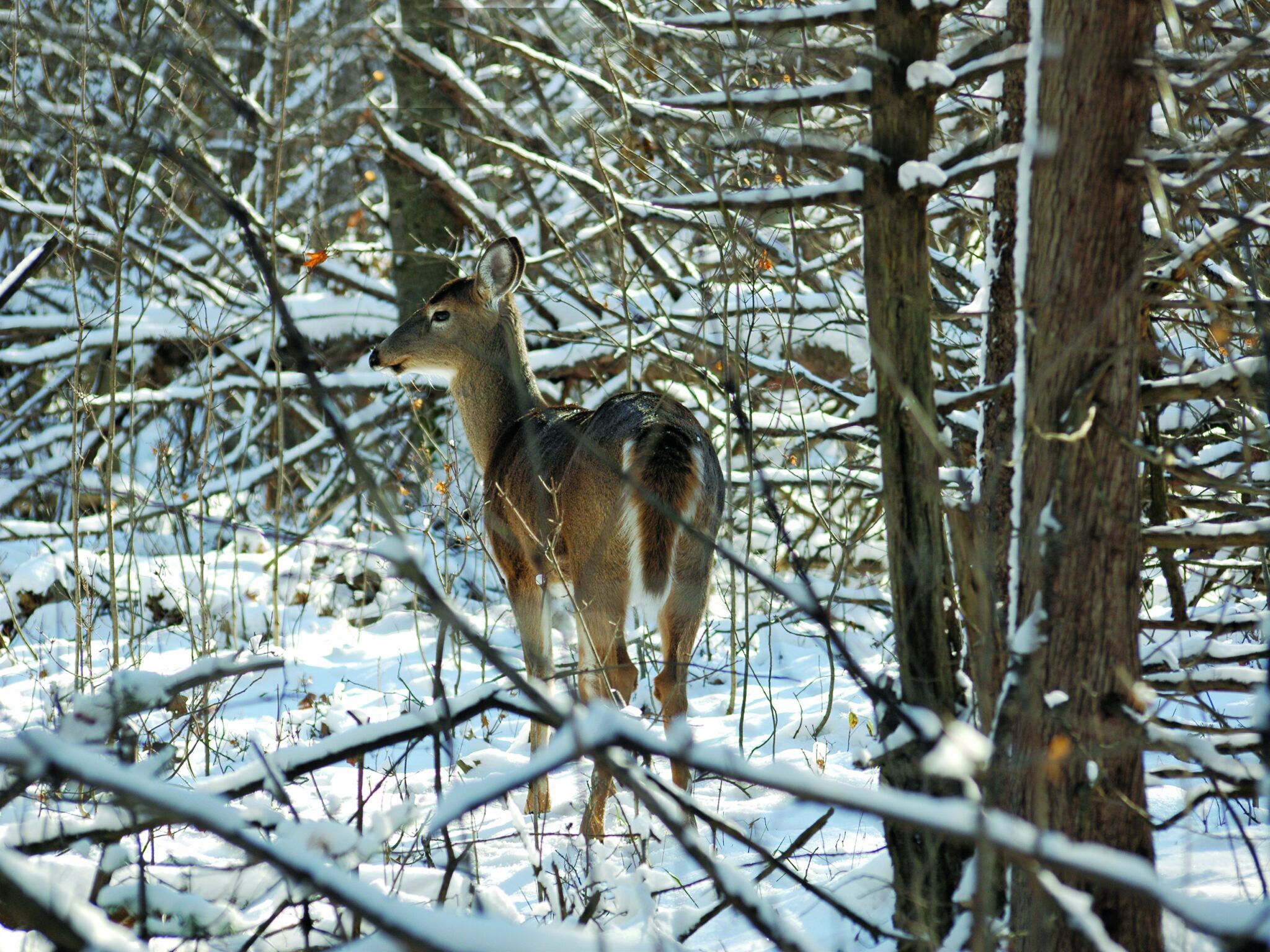Winter presents a real challenge for the plants and animals in Gatineau Park. How do they survive the cold, the lack of light and the lack of food?
How Plants Weather the Winter
In winter, it’s not uncommon to see a nature interpreter leading a group of rosy-cheeked people on snowshoes on a trek to discover more about Gatineau Park. As they make their way among the leafless trees, noting the amount of snow that a coniferous tree branch can support, they quickly realize that not all plants have the same ways of surviving until spring.

Sub-zero temperatures and dry conditions — due to the fact that water is frozen and therefore inaccessible — are the most difficult types of conditions for trees and plants.
- The leaves of deciduous trees fall, allowing the tree to avoid dehydration.
- The needles of coniferous trees are dark green to help the tree absorb the maximum amount of energy from the sun. Needles contain resin, are coated with wax, and have sweet sap to prevent dehydration and freezing.
- The leaves and stems of herbaceous plants die, allowing the roots and bulbs to save the energy needed to grow again in the spring.
Nature interpreters like to point out little-known facts that might surprise people exploring the Park on guided hikes. For example, it is often mentioned that trees produce buds during the summer. It’s true! Trees use the energy available to grow buds and cover them with scales, hair or wax before winter. When spring arrives, the buds are already there, ready to open.
Survival Strategies of Gatineau Park Animals
Under a bright blue sky, zigzagging through the Park’s winter forest on snowshoes, the nature interpreter may highlight that, in the cold season, it’s not possible to observe many of the Park’s animals. Cold temperatures, difficult travel, scarcer food supply and reduced light energy are survival challenges that animals face. Here are a few well-adapted strategies specific to some Park species.
Beavers remain active throughout the winter. They build a dam to raise the water level. This enables them to swim under the ice and access their food supply — a stockpile of branches at the bottom of the pond.

White-tailed deer migrate to the Eardley Escarpment, where the snow cover is thinner. Viewed from above, the area reveals deer yards. These well-trodden paths are repeatedly used by deer to get around, helping them save energy in the wintertime.
The snowshoe hare increases its chances of survival by saving energy when travelling. An adult hare weighs only 1.2 to 1.8 kilograms. This little mammal feeds on available greenery, even in the winter, and it does not store any body fat. Also, because its weight is evenly distributed over its large hind feet, it is able to travel on top of the snow, while other animals — including its predators (foxes, coyotes, wolves and humans) — sink into the snow.

The ruffed grouse has a unique way of keeping warm and at the same time protecting itself from predators. From atop a tree branch, it drops into the powdery snow below, where it becomes buried. In this way, it is both camouflaged and covered by a layer of natural insulation.

Telltale Tracks

When snowshoeing, we are able to identify and follow the tracks left by an animal in the layer of snow on the ground, which can be like a perfect white canvas. If we take a close look and are careful not to destroy the tracks as we get closer, we can identify which animal made them, and the direction in which it was travelling.
Perhaps you think you’ve identified a fisher’s tracks. Pay close attention. It could also be the tracks of another member of the mustelid family, which includes mink, weasel, ermine and American marten. To distinguish among these animals, look at the size of the footprint and the distance between the feet.
If you see tracks with the entire foot pad imprinted in the snow, long claw marks and a trail left by a dragging tail, then the tracks were left by a porcupine. In thick, soft snow, porcupines leave a trough-like path.
If you want to try your hand at being a nature interpreter when snowshoeing in a forest in winter:
- Examine the size and various details of the footprint by measuring the length and width of the print.
- Count the number of toes.
- Note the length of the animal’s stride by measuring the distance between the footprints.
- Observe the distance between the left and right foot.
- Analyze how the animal moves. In a straight line? Diagonally? By jumping?
The Joys of Winter
It is when we stick our noses outside, even in cold weather, that we can appreciate what winter has to offer. In Gatineau Park, you can enjoy the winter on cross-country skis, snowshoes, snow bike or while doing some winter hiking. All you have to do is make sure that you have all the information you need to stay safe and that you’re on the right trail for your activity.
So, bundle up — and enjoy some winter fun!